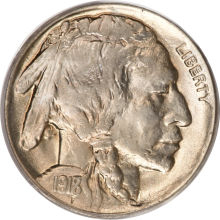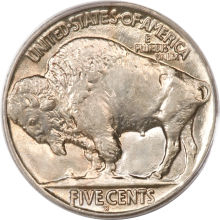 1918/7-D 5C MS65 PCGS. FS-101, formerly FS-016.5. The years 1917 and 1918 saw an unprecedented production of small change at all of the U.S. Mints. This heightened production was in response to a serious shortage of small denomination coinage, possibly caused by hoarding and the transportation of much small change overseas. More than one million American soldiers served on European battlefields in the last two years of World War I, and every one of them carried at least a few cents and nickels with him. The coins were eagerly accepted by French merchants, who particularly liked the nickel. David Lange tells of this contemporary newspaper account, "The French like the American 5-cent piece. 'Elle est jolie,' they say, comparing it to the French coin of the same denomination with a square hole in the center." To make up for this drain on the domestic supply of coinage, all U.S. Mints were working overtime in late 1917.
1918/7-D 5C MS65 PCGS. FS-101, formerly FS-016.5. The years 1917 and 1918 saw an unprecedented production of small change at all of the U.S. Mints. This heightened production was in response to a serious shortage of small denomination coinage, possibly caused by hoarding and the transportation of much small change overseas. More than one million American soldiers served on European battlefields in the last two years of World War I, and every one of them carried at least a few cents and nickels with him. The coins were eagerly accepted by French merchants, who particularly liked the nickel. David Lange tells of this contemporary newspaper account, "The French like the American 5-cent piece. 'Elle est jolie,' they say, comparing it to the French coin of the same denomination with a square hole in the center." To make up for this drain on the domestic supply of coinage, all U.S. Mints were working overtime in late 1917.
One unintended consequence of this extra Mint activity was the production of several important overdates in the coinage of 1918. Both the quarters of the San Francisco Mint and the nickels of the Denver Mint are known in overdate varieties, and each variety is a prized rarity to collectors today. The overdate dies were created by a hubbing error that occurred in late 1917, when dies dated 1917 were still in use and dies for the next year were hurriedly manufactured. In The Complete Guide to Buffalo Nickels,David Lange describes the likely sequence of events:
 "In sinking a working die, two or more impressions had to be taken from a working hub. Between each impression, the developing die was taken to the furnace to be annealed, or softened, since the first impression caused the metal to become workhardened. It was then ready for another impression. Amid the haste to produce new dies, a working die that had already been impressed with a hub dated 1917 was then either inadvertently or intentionally given another impression from a hub dated 1918. The result was an overdate."
"In sinking a working die, two or more impressions had to be taken from a working hub. Between each impression, the developing die was taken to the furnace to be annealed, or softened, since the first impression caused the metal to become workhardened. It was then ready for another impression. Amid the haste to produce new dies, a working die that had already been impressed with a hub dated 1917 was then either inadvertently or intentionally given another impression from a hub dated 1918. The result was an overdate."
The overdate feature went unnoticed by numismatists of the early 20th century and the coins circulated extensively for a long period before it was discovered. Exactly when the error was first noticed is unclear. David Lange references an appearance on March 15, 1930, in an auction held by dealer Paul Lange of The Hobby Shop. Q. David Bowers notes an appearance in a Barney Bluestone catalog in 1931. Neither of these events was widely noticed by the numismatic fraternity, and the issue languished in obscurity until the late 1930s when collecting Buffalo nickels became widespread. By the time of the Adolphe Menjou Sale (Numismatic Gallery, 6/1950), catalogers had become familiar with the variety. Lot 597 of that sale reads, "1918 over 17 D. Only fine but rare, lists in very fine condition at $50.00."
An important step in the developing popularity of the coin was its listing in the first edition of the Guide Book of United States Coins 1947. The Guide Book was actually published in 1946, but had the following year's date on the cover. The variety was listed on page 88 as "1918D over 7." The price was listed as $40.00 in fine and $150.00 in Uncirculated. The popularity of theGuide Book ensured that knowledge of the variety would spread and its value would increase accordingly.
The exact mintage of 1918/7-D Buffalo nickels is unknown, but Bowers estimates an original production figure of about 100,000 pieces. Because the coins circulated for so long before the variety was noticed, the great majority of the surviving population is in lower circulated grades. The typical example seen today is in the VG-VF range. Many example doubtless exist in grades below VG, and more than 100 specimens have been graded, but the overdate is difficult to detect because of wear on the date. Coins grading AU are seldom encountered, and Mint State specimens are rare. The number of surviving specimens in Mint State grades is another mystery. Population data in the lower Uncirculated grades has been distorted by resubmissions. Walter Breen guessed possibly six specimens survive in Uncirculated grades, but that estimate is certainly too low. Lange estimates approximately two dozen example are extant in Mint State grades, a more reasonable figure. We would not be surprised if the real total was larger still, say around 35-40 pieces. The two major grading services have certified a total of seven specimens at the Gem level, with four at NGC and three at PCGS. Neither service has graded an example in any higher grade (11/09).
All 1918/7-D nickels are from the same die pair. The present coin shows fine traces of a die crack extending from the braid across the Indian's face. A few specimens from an early die state are reported without the die break, but the feature is generally considered diagnostic. The coin offered here is truly a magnificent specimen. The warm, thick, satiny surfaces are lightly toned, with a pale overlay of gold and occasional hints of lilac. The considerable visual appeal is augmented by the amazingly sharp strike, which imparts nearly full detail to all design elements. The only mark of distinction is a glancing, diagonal mark on the bison's body, between the withers and the hump. The high technical grade, intense aesthetic appeal, and fascinating history of this coin combine to make this offering one of the most desirable examples of 20th century coinage.(Registry values: N14284) (NGC ID# 22RJ, PCGS# 3939)
(C) 2013. Heritage Auction Galleries. All rights reserved. Used with permission.